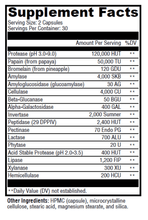-
 physician-grade products
physician-grade products -
 based on latest research
based on latest research -
 clinically-relevant dosing
clinically-relevant dosing -
 purity-tested ingredients
purity-tested ingredients
VEGETARIAN DIGESTIVE AID THAT COMBATS STOMACH ISSUES
Millions of people in the United States experience gut-health-related issues, such as acid reflux, that require a digestive aid in order to resolve. Digestive enzyme supplements are becoming an increasingly popular way to naturally improve gut health and support proper, functional digestion. With so many gut health supplements on the market, you really need to know which ones contain the enzymes you're lacking. For example, those who are lactose intolerant will only find relief from related symptoms if they are taking an aid that contains lactase, an enzyme that counteracts the effects of lactose.
We carry Celarity's Complete Enzyme and support it 100 percent. This gluten-free digestive enzyme supplement contains numerous thoroughly studied enzymes that can help those with even the most severe stomach-related issues. Those with everything from malabsorption to Crohn's Disease should be able to find relief with these vegetarian digestive enzymes.

What is Complete Enzyme?
Digestive enzymes are an incredible tool that should be utilized when facing gut conditions or distress. People lack proper levels of digestive enzymes in their gut for many reasons, but they are absolutely crucial. Digestive enzymes break down food into amino acids, fatty acids, cholesterol, and simple sugars, which all help to make DNA. In the clinical setting, I use digestive enzymes with many gut conditions.
- Support healthy digestion of macronutrients and increases nutrient absorption
- Support breakdown of lactose
- Supports pancreatic and brush border enzyme function
- Supports the breakdown of polysaccharides in beans and cruciferous vegetables
If digestion is unhealthy (like in the case of Leaky Gut), incompletely digested molecules and proteins can enter into the bloodstream and be recognized as foreign invaders. This in turn will ramp up the immune system causing food intolerances, skin reactions, fatigue, bloating and more.
- Acid reflux
- Gas
- Bloating
- Leaky Gut
- Irritable Bowel Syndrome
- Crohn’s Disease
- Ulcerative Colitis
- Diverticulitis
- Malabsorption
- Diarrhea or constipation
- Weight Gain
- Nutrient Deficiencies
As we age, the acidity in our stomach starts to become more alkaline. This is called hypochlorhydria, or decreased amounts of stomach acid. Though this happens in the elderly, it can also happen in younger individuals as well. When the acid is low it fails to trigger a sequence of reactions in the digestion process. If the acidity trigger fails, then the signal is not passed on to secretin and this ultimately prevents pancreatic secretions from releasing enzyme support.
Every digestive enzyme has a particular mission in the body as it pertains to digestive. Here is a breakdown of the enzymes found in the Celarity Complete Enzyme product.
Alpha – Galactosidase: This enzyme hydrolyses the terminal alpha-galactosyl moieties from glycolipids and glycoproteins found in legume, starchy carbohydrates and hard to digest foods. In absence of this enzyme carbohydrates can pass into the large intestines where microbes can ferment and produce volatile gasses.
Beta Glucanase: This is a group of carbohydrate enzymes which are for the purpose of breaking down glycosidic bonds within beta-glucan. These glucans also create up to 60% of the cell wall of many forms of fungal organisms such as C. albicans and candidal biofilm (the common experience of candida in the gut).
Bromelain: Bromelain is a protein-digesting enzyme complex found in the fruit and, in higher concentrations, in the stem of the pineapple. It is able to hydrolyze or break down a wide variety of protein types in a range of both acid and alkaline environments.
Cellulase & Hemicellulase: These enzymes break down the major fibers in fruits and vegetables called cellulose and hemicellulose. Cellulase breaks down cellulose into beta-glucose and hemicellulase metabolizes hemicellulose. Glucose from cellulose is released slowly and should not dramatically increase blood sugar but rather provide a more stable fuel for the body.
Glucoamylase: This enzyme breaks off a free glucose molecule from the complex sugar-based chains that form starch, disaccharides or polysaccharides. The glucose can than be freed up as a source of energy for the body.
Invertase: This enzyme breaks down sucrose into fructose and glucose. Sucrase is secreted by the tips of the villi of the small intestine. Individuals with celiac disease or intestinal inflammation may have trouble producing adequate invertase.
Lactase: The enzyme lactase is required to break down lactose into glucose and galactose before the intact lactose can draw excess water into the bowel, and before colonic bacteria can break it down into volatile gases and acids. Though lactose (a disaccharide found only in mammals’ milk) is readily digested by most infants, normal production decreases as a child is weaned onto whole foods and may eventually cease in adulthood.
Exogenous administration of lactase can support lactose digestion effectively and allow for continued consumption of milk-based products. Maintaining a healthy gastrointestinal flora helps support brush border function and digestive capacity as well.
Lipase: Lipase is an essential enzyme for the digestion of fatty (lipid) substances either in the diet or as a part of normal human metabolism. It is responsible for breaking down fats into smaller components that can readily be absorbed through the intestines.
Pectinase: This enzyme helps to metabolize the pectin wall of vegetables. This is crucial because pectin is a gelatinous matrix which helps cement plant cells together and in which other cell wall components, such as cellulose fibrils, are embedded. Therefore pectinase enzymes are huge for complete digestion of many fruits and vegetables.
Phytase: Phytase is present to facilitate the breakdown of indigestible phytates (phytic acids) from grains and seed and release phosphorus, calcium, inositol and other nutrients for absorption.
Proteolytic Enzymes: Proteolytic enzymes are necessary to metabolize protein molecules into amino acids. When individuals have a compromised digestive tract they are unable to secrete adequate amounts of these proteolytic enzymes and they end up with large protein molecules that further irritate the gut and poor amino acid absorption which leads to deficiencies.
Protease and Peptidase: Protease is a type of enzyme that functions mainly to help us digest different kinds of proteins. They break down the bonds by a process known as hydrolysis and convert proteins into smaller chains called peptides or even smaller units called amino acids.
Papain: This key enzyme is extracted directly form papaya fruit, it is also referred to as papaya proteinase. The papaya-enzyme papain plays a key role in breaking down and digesting tough protein molecules found in meat.
Xylanase: These enzymes break down the polysaccharide beta 1,4-xylan into xylose. This is one of the keys to breaking down the plant cell wall for optimal digestion.
Count: 60 vegetarian capsules
Suggested use: Take one to two capsules daily, or use as directed by your healthcare practitioner. If necessary, capsules may be opened and contents sprinkled over food.
Does not contain: Wheat, gluten, yeast, soy, animal or dairy products, fish, shellfish, peanuts, tree nuts, egg, ingredients derived from genetically modified organisms (GMOs), artificial colors, or artificial sweeteners
References:
1. Bland J, Liska D, Jones DS, et al. Clinical Nutrition A Functional Approach. 2nd ed. Gig Harbor, WA: The Institute for Functional Medicine. 2004.
2. Whitcomb DC, Lowe ME. Human pancreatic digestive enzymes. Dig Dis Sci. 2007 Jan;52(1):1-17. Review. [PMID: 17205399]
3. Sanders SW, Tolman KG, Reitberg DP. Effect of a single dose of lactase on symptoms and expired hydrogen after lactose challenge in lactose-intolerant subjects. Clin Pharm. 1992 Jun;11(6):533-8. [PMID: 1534729]
4. Heyman MB; Committee on Nutrition. Lactose intolerance in infants, children, and adolescents. Pediatrics. 2006 Sep;118(3):1279-86. Review. [PMID: 16951027]
5. Zaouche A, Loukil C, De Lagausie P, et al. Effects of oral Saccharomyces boulardii on bacterial overgrowth, translocation, and intestinal adaptation after small-bowel resection in rats. Scand J Gastroenterol. 2000 Feb;35(2):160-5. [PMID: 10720113]
6. Di Stefano M, Miceli E, Gotti S, et al. The effect of oral alpha-galactosidase on intestinal gas production and gas-related symptoms. Dig Dis Sci. 2007 Jan;52(1):78-83. [PMID: 17151807]
7. Ganiats TG, Norcross WA, Halverson AL, et al. Does Beano prevent gas? A double-blind crossover study of oral alpha-galactosidase to treat dietary oligosaccharide intolerance. J Fam Pract. 1994 Nov;39(5):441-5. [PMID: 7964541]
https://www.ncbi.nlm.nih.gov/pmc/articles/PMC4133...
https://www.ncbi.nlm.nih.gov/pmc/articles/PMC4923...
https://www.ncbi.nlm.nih.gov/pubmed/21465223/
**Additional references available upon request
Disclaimer: These statements have not been evaluated by the Food and Drug Administration. This product is not intended to diagnose, treat, cure or prevent any disease.




